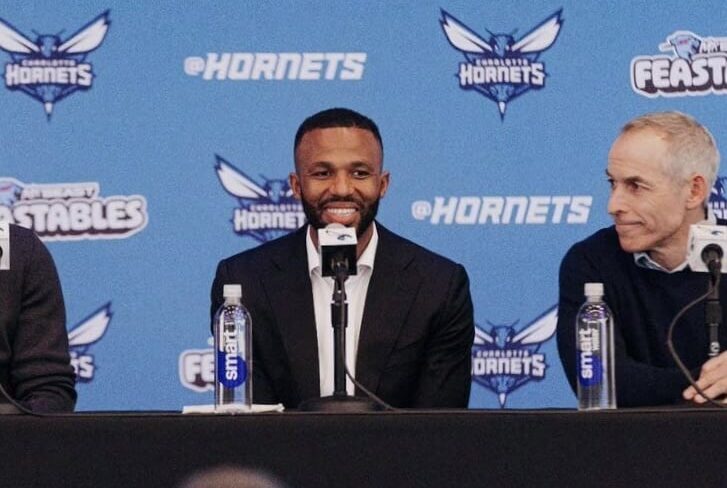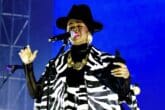June 21, 2024
Since taking over in March, Executive Vice President of Basketball Operations Jeff Peterson has been laying the framework for a new era for the Charlotte Hornets. Now Peterson and company are gearing up to make their first draft pick on June 26 with the sixth overall selection.
Led by Peterson, an almost entirely new cast of decision-makers will have a valuable top-10 draft pick along with a mid-second-rounder (quick reminder: the NBA Draft will be a two-day event starting this year). Since being officially hired, Peterson and his staff have mostly been in evaluation mode. Charles Lee has already filled out his coaching staff and began working, fresh off a championship with the Celtics. Now, it’s time for the new executives to put their collective fingerprints on the Hornets roster.
The mainstream narrative and prevailing opinions regarding the 2024 draft are not kind; for the entire draft cycle, the dearth of talent at the top of the class has been maligned. It’s why Charlotte dropping from three to six in the draft lottery wasn’t much of a disappointment among media members and the fanbase. Despite the narrative that there’s little star power in this year’s draft class, the Hornets stand to benefit from their draft position in a few ways.
First, whichever player lands in Buzz City will arrive with less pressure than the typical No. 6 pick, given few expect this year’s sixth-best player to have All-Star caliber upside. On top of that, the sixth pick seems to be an inflection point in the draft this year. Recent mock drafts by ESPN, Bleacher Report, The Athletic and Yahoo Sports formed a consensus top-five of Alex Sarr, Zaccharie Risacher, Stephon Castle, Matas Buzelis and Reed Sheppard, with only Yahoo’s Krysten Peek having Donovan Clingan in Sheppard’s place. If the consensus top-five players come off the board on draft night and Charlotte is left with Clingan or the field, Peterson will have an interesting decision to make.
The Hornets could decide to accumulate assets by trading down rather than take a chance with the sixth pick, since there will likely be suitors assuming Clingan, Sheppard or another highly-touted prospect is on the board. Memphis and Chicago sit at nine and 11, respectively, and have rumored interest in Clingan. ESPN’s recent mock draft posed the sixth pick as Sheppard’s floor after the soon-to-be 20-year-old shot 53.6% from the field, 52.1% from 3-point range, and averaged 2.5 steals per game in his lone season at Kentucky.
Memphis is a particularly appealing trade partner as a team on the verge of contention with a fully healthy roster that has plenty of low-salary contracts and future picks. For example, the Hornets could swap No. 6 for No. 9 and Santi Aldama, Jake LaRavia or Ziaire Williams. Similarly, they could swap with Chicago for the No. 11 pick and Ayo Dosunmu, though that’s not as appealing given Charlotte’s guard depth. A myriad of options could open up as the draft inches closer.
Currently, there seems to be a host of prospects in consideration; Dalton Knecht is the pick in ESPN’s latest mock, The Athletic pegged Castle to Charlotte, Bleacher Report has Clingan, and Yahoo Sports has Sheppard. Each of these players bring a vastly different skillset to the table and a case could be made for any one of them.
Castle and Clingan, teammates at Connecticut during last year’s dominant national championship run, have been commonly linked to Charlotte throughout the draft process. In Castle’s case, he slots in alongside LaMelo Ball and Brandon Miller, and can take the toughest defensive assignment of the three, while offering slashing and secondary playmaking as ancillary skills. Though the Hornets already have two seven-footers in Mark Williams and Nick Richards, Clingan is a true gargantuan at 7-foot-2 and 280-plus pounds with the ability to move his feet in space, set brick wall screens, make quick-decision passes, and utilize his brute force to score down low.
Knecht is by far the oldest prospect at the top of the draft; at 23 years old, only he, Tristan da Silva and Baylor Scheierman are even in play to be first-round picks as older prospects. Scintillating scoring ability at all three levels of the court, and clear NBA athletic traits separate Knecht from his fellow seniors. Adding a third reliable shot creator to the Ball-Miller-Williams nucleus is paramount, as the Hornets’ offense has been at the bottom of the league in each of the last two seasons. Critics would argue he’s too one-dimensional and doesn’t offer enough as a defender, rebounder or passer, but the scoring alone is going to give Knecht plenty of opportunities to further develop in the NBA.
It’s tough to argue against Reed Sheppard’s case for “best shooter in the draft.” The aforementioned 53%/52% splits from the field and 3-point range are historically great for a freshman, and Sheppard did all of this with little expectation he’d even be a one-and-done prospect, much less a top-five pick. Being only 6-foot-2, he may face an upward battle to become a starter in Charlotte with Ball and Miller providing advantageous positional size in the backcourt. But even then, the high floor of a prospect with every shooting indicator in the book along with productive defense and secondary ball-handling, might be too tough to pass up.
On day two, Charlotte holds the 42nd overall pick. With the increasing emphasis on two-way players in the draft the last few years, the players taken from 40 onward tend to sign two-way contracts rather than guaranteed deals. Two-way contracts are essentially reserved for hybrid NBA and G League players, spending most of the year developing in the G League. Teams can promote their two-ways if they’re in need of depth, or that player performs well enough to be called up.
That’s especially beneficial now that there are three two-way slots– teams can save a spot on the 15-man roster for a trade or free agency acquisition by signing a second-round pick to a two-way contract instead of a guaranteed deal.
The prospects in consideration at No. 42 will depend on those willing to sign a two-way contract, opposed to holding out for a guaranteed deal or opting to be stashed overseas. Not every prospect wants to play their rookie year on a two-way deal– apart from the lower salary, it limits players to be active for only 50 NBA appearances in a season. Some prospects prefer a clearer runway to playing time, but the two-way path has worked out decently for Charlotte with Amari Bailey and Bryce McGowens in recent years.
The 2024 draft is Peterson’s first big move on the Charlotte Hornets’ offseason chessboard. He and his staff haven’t had the opportunity to trade or sign players yet– though that will come just three days after the draft at 6 p.m. on June 30. For Hornets fans, Peterson’s vision for becoming a premier franchise will become much clearer in the next few weeks, and it all starts with the sixth pick on Wednesday night.
The first round of the 2024 NBA Draft will air live on ESPN and ABC beginning Wednesday, June 26 at 8 p.m. from Barclays Center in Brooklyn, New York. The second round will air Thursday, June 27 at 4 p.m. on ESPN.
Read next:

 By
By 

